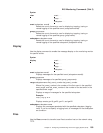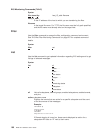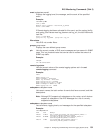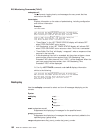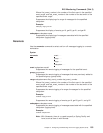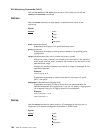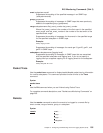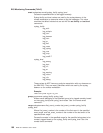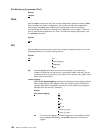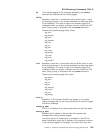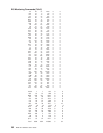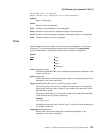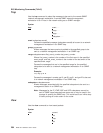
Example:
remote range gw 19 22 log_user log_info
Causes the event gw.19, gw.20, gw.21, and gw.22 to be logged remotely to
the files specified by the
syslog_facility
value of log_user and the
syslog_level
value of log_info.
subsystem
subsystem.name message_level syslog_facility syslog_level
Where
subsystem.name
is the name of the subsystem and
message_level
is the level of messages selected in the subsystem.
Causes the events within the specified
subsystem.name
whose
message_level
agrees with the specified
message_level
to be logged
remotely based on the
syslog_facility
and
syslog_level
. See “the remote
event command” on page 196.
Message_level
is a value such as “ALL,” “ERROR,” “INFO,” or “TRACE” .
See “Logging Level” on page 149. The value specified in the remote
command must agree with the value as coded on the particular event within
the subsystem, or that event within the subsystem will not be remotely
logged.
Example:
remote subsystem TKR all log_user log_info
In the above example, all messages in subsystem TKR (“all” includes any
messages coded for “error,” “info,” or “trace”) will be logged remotely to files
specified by log_user and log_info at the remote host.
Use the list event and list active commands to verify what you set with the
remote and noremote commands.
Remove
Use the remove command to free up memory by erasing stored information. If you
have previously saved the current configuration with the save command, remove
allows you to erase the saved configuration.
Syntax:
remove
Restore
Use the restore command to clear all current settings (except counters) and reload
the initial ELS configuration. To retain the current settings, use the save command
before restoring the initial configuration.
Syntax:
restore
Retrieve
Use the retrieve command to reload the saved ELS configuration. If you have
previously saved the current configuration with the save command, use retrieve to
reload it. Retrieve does not erase the saved configuration after it executes. To
erase the saved configuration, use the remove command.
ELS Monitoring Commands (Talk 5)
Chapter 13. Configuring and Monitoring the Event Logging System (ELS) 197



